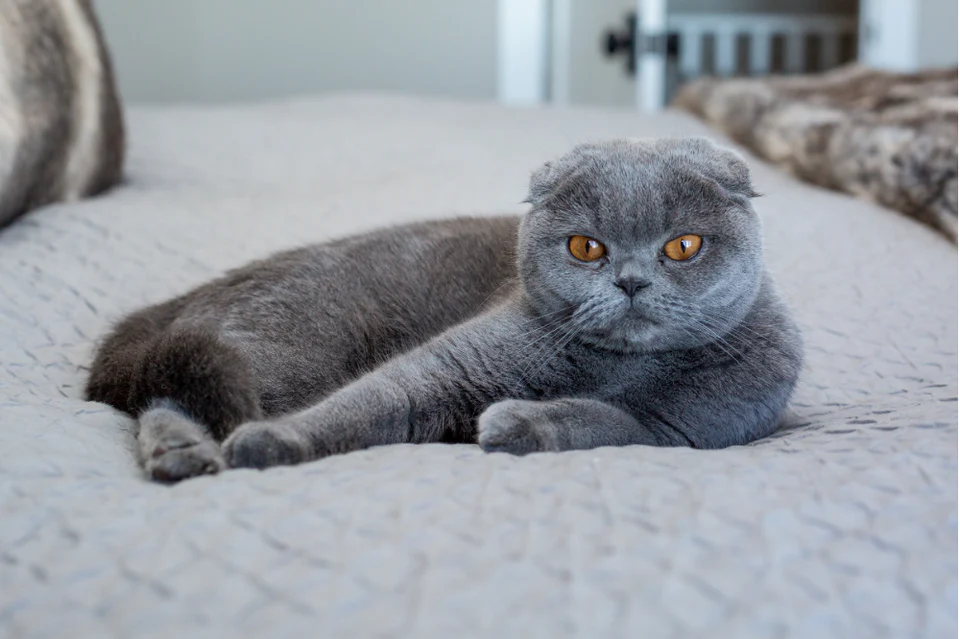
9 Ways to Keep Your Cat Feline Fine!

Probably everyone, pet parent or not, has heard the old adage that cats have nine lives. (Well, in certain cultures, they have seven.) This idea mostly comes from their well-known ability to survive falls or impacts that might hurt or kill other animals.
As for the seven vs. nine, it’s probably just a matter of choice. In each case, it seems to be based on a sacred number, either seven itself, or three times three.
Of course, we all know that our cats really only have one life. As pet parents, it’s our job to make sure that our feline fur-kids have the longest, healthiest, happiest lives possible. Here are nine things you can do to make that happen.
Start with the right tools
Like dogs, cats require the right accessories, which should be in your home before the cats arrive. Of course, if you already have one or more cats, then you already have a lot of these things — but are you doing it the right way? For example...
1. Have enough litter boxes
If you’ve ever lived in a house with too many people and not enough bathrooms, you already know why this is important — a family of four sharing one bath can be a nightmare. It can even be bad enough when it’s just two roommates.
It’s similar with cats, and veterinarians even have a name for it: the N+1 rule. In this case, “N” is the number of cats, and you should always have one more litter box than you do cats. In other words, two boxes for one cat, three for two cats, and so on.
Also, if your home has multiple stories, there should be at least one litterbox on each floor, which means that if you happen to have three or more floors, you’re going to have more than just one more box than cats.
For multiple cats, this is essential to avoiding any conflicts among them. For example, a cat may just naturally want to share their space with another cat. And woe to you if you have one covered litter box and multiple cats! That’s a good way to get your wall sprayed as cats try to mark it as theirs.
As for two boxes for one cat, that has several practical reasons. One is that if your cat like to take care of business in private, they’ll probably have a box to go to that’s away from where the people are at the moment.
The other is for you. If you’re too busy one day and forget to clean one box, there’s still the other, ready and waiting.
2. The ol’ scratching post
I know that a lot of dog lovers roll their eyes at these, because we don’t need any such elaborate constructions for our four-legged friends. Oh, excuse me, part of the agility course in the yard just blew over. Be right back...
Where was I? Right. We’ve all seen these sometimes elaborate, carpet-covered towers that look like the ultimate unnecessary indulgence, but they are actually extremely useful.
For one thing, they provide exercise and mental stimulation for cats. More importantly, though, they keep your cat from turning things like your furniture or clothes or device screens into their own personal scratching posts.
Although, did you know that you do have to train your cat how to use one? That part is news to a lot of people, because it seems like it’s something they’d do naturally. But cats in the wild don’t run into a lot of vertical, carpet-covered objects.
A scratching post also helps your cat to stretch their muscles, since it involves a lot of reaching up and using their forelegs, so this will also keep them physically fit.
3. A place of their own
All of that scratching can wear a cat out, so make sure to have a nice, comfy bed ready for them. Just learn your cat’s sleeping preferences first.
True to the internet meme of “If I fits, I sits,” some cats like to stuff themselves into tight, comfy spaces, so they might prefer covered beds. Even if they’re a bit less into totally hiding themselves, many cats prefer a bed with high sides.
Why is this? It’s instinctual, and a way for them to hide from predators while also being invisible to potential prey.
Remember: Cats sleep a lot! Typically up to fifteen but as many as twenty hours a day. This is because they are neither diurnal (active by day) or nocturnal (active by night), but crepuscular — meaning active just before and after sunset and dawn. We should be so lucky!
4. It’s an inside job
This is a constant debate among cat lovers, but the evidence seems to lean heavily toward keeping your loved ones as indoor cats. They don’t need to go outside to be mentally stimulated. Besides, outside is full of all kinds of dangers.
Even urban areas, like Los Angeles, have predators, and many a pet parent there have lost a loved one to a coyote — even if they lived down in the concrete part of the city.
But cats can also be a danger to the local wildlife, meaning that resident squirrels, birds, and opossums are not safe. In one extreme case, a cat in Australia single-pawedly wiped out an entire colony of endangered birds.
The one big advantage of keeping your cats inside is that it will provide lots of opportunities for bonding — both humans and cats. It will give you a chance to play together, to cuddle, and just get to know each other a lot better.
There are ways, though, that you can bring some of the outside to your inside cat. For example, if you have the means, you can create a screened-in area for them to hang out in. For example, if you have an enclosed porch, consider screening it so the cats can hang out there.
Or, you can be creative. Buy and install or build your own cat window-box, which is cleverly referred to as a Catio. This will create a safe enclosed space with mesh sides that your cat can access via a window or a cat-door installed in the wall.
And, finally, nothing says you can’t take a cat for a walk just like you can a dog — although it does depend on the cat’s temperament.

The importance of diet
Just like with humans, diet plays an enormous role in the health of our cats. Making sure they eat the right things and don’t eat the wrong things are key.
5. Avoid foods that are toxic to cats
It’s important to keep in mind that many things that humans eat routinely can make a cat seriously ill or possibly even lead to their death. For the sake of space, I won’t get into the specific dangers, but I will give you a list of just a few things cats should never eat:
- Plants in the allium family — like onions, garlic, shallots, and scallions
- Raw eggs, meat, and bones
- Chocolate and caffeine
- Alcohol and raw dough with yeast
- Grapes and raisins
The general rule is to keep your cats out of the kitchen when you are preparing food, if at all possible and, if not, never allow them on the kitchen counters at any time. Make sure that food in your cabinets is not accessible, and is kept in tightly sealed, cat-proof containers.
You might also want to consider cat-proof cabinet locks which also double as safety locks if you live in earthquake country.
Never feed your cat (or your dog) table-scraps, and be especially vigilant during holidays that revolve around big meals when the confusion of big gatherings (when we can have them again) can provide plenty of opportunities for table-raids.
6. Sorry, your cat cannot be a vegetarian
Or a vegan. Unlike dogs, who can tolerate a diet without meat, cats are what are known as obligate carnivores. That is, unlike a lot of other animals, they have to eat meat in order to survive. Without it, they will die.
A big reason is the amino acid taurine, Humans and dogs, among other animals, produce it naturally in their bodies. Cats cannot. And since they can’t chug energy drinks because of the caffeine (see above) their only option is to eat one of its sources: meat, fish, or dairy — although cats don’t necessarily do so well on dairy, either.
As for the source of that meat-based protein, the debate over wet vs. dry food rages on, with arguments on both sides. Some vets believe that too much dry food can cause UTIs, feline diabetes, and obesity, but the real answer, as with everything is — it depends.
Consult with your vet, and monitor your cat’s food intake and health changes to find the right balance. The reminder to take a proactive role in your cat’s health is a nice segue to the next section...
Attention must be paid!
Just like cars, houses, or pretty much everything else, our pets require regular maintenance. That’s a no-brainer, of course, and some things are obvious. They need food and water, and access to a place to go to the bathroom, as well as a safe and comfortable space to sleep in.
But, there are a few more things that require your attention...
7. Brush, brush, brush your cat
This would refer to both your kitty’s coat and teeth. For each, daily if possible, but at least three times a week.
You can learn how to avoid common cat-brushing mistakes, and learn how to brush their teeth, or at least get them used to it without you sacrificing an arm in the process. This way, you can attend to your cat’s physical upkeep. They may also eventually realize that you’re appealing to their vanity, and thank you for it.
On a serious note, the regular hair brushing can help avoid things like the dreaded hairballs, since cats spend so much time grooming themselves. It’s also an excellent time to look for fleas, unusual bumps, or other bodily changes that would require medical attention.
As for the importance of dental hygiene, we’ll have more on that subject later this month.
8. Their actions speak louder than words
So your litter box trained cat just peed in the living room. If you’re like a lot of pet parents, your first assumption might be that they were just being bad or trying to tell you off for something.
In the case of cats, don’t start here. Rather, if your litter-trained cat suddenly starts tinkling outside the box, the first thing you should do is take them to the vet.
Why? Because this is often the first sign of a urinary tract infection or something like that, and the sooner you catch it, the better. This will allow your vet to quickly treat it with antibiotics before it turns into a dangerous bladder infection or worse.
Trust me. Blaming your very well-trained pet for that sudden accident without getting it checked can be a very bad mistake.
Besides, if your cat is really angry with you, they’ll send the message in a different way, and you’ll find a more solid surprise on your pillow or in your favorite pair of shoes.
9. Spaying and neutering are absolute musts
Spaying and neutering are the healthiest choices for cats and dogs, but we’ll have more on that later this month. The short version is that spaying and neutering can lead to longer lives by preventing breast or testicular cancer, as well as mating-related behavioral problems. And, psychologically, your pets will not know the difference.

Live long and prosper!
So there you have it: Nine things you can do to make your cat’s one life at least nine times better. But here’s the best part: A healthy pet is a happy pet, and a happy pet in turn has a much happier parent.
A happier human is a healthier human, too. So these nine steps are just as much for your benefit.
Here’s to all our pet parents and their cats feline fine and having long and healthy lives together!
Share this article
written by

